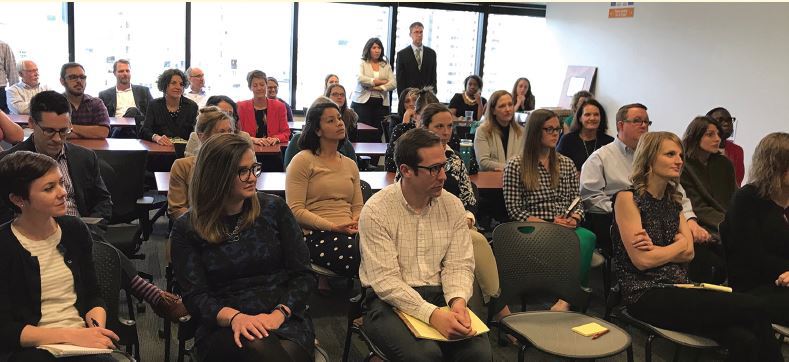
The Education Commission of the States had a collective professional development event in the art of storytelling to help all employees best understand how to tell a story that is meaningful and impactful during its All-Staff Retreat in 2018.
“This was helpful for them in defining their own roles and importance within our organization, and also for sharing the service we provide to our constituents in all 50 states,” said Jeremy Anderson, president of Education Commission of the States (ECS), based in Denver.

It didn’t stop there. ECS leaders might well have used the old adage that the way to a person’s heart is through their stomach. The organization “focused on healthy eating and lifestyles where we had a chef for a local restaurant come in and talk about food preparation, how to get the most nutritional food into your diet, and the value of a life/work balance,” explained Anderson. “The training culminated with a lunch completed for all of our staff that was prepped and cooked in front of the staff so they can see how simple some of the great food can be to create on their own.”
Professional development comes in all shapes, sizes and methods in the nonprofit sector. Training and professional development budgets of organizations polled by The NonProfit Times ranged from as little as $10,000 to more than $1 million. Of course, in this case size of organizations matters.
The amounts allocated are often not simply a percentage of an organization’s annual budget. For example, at the Legal Aid Society of the District of Columbia (LASDC) the allocation is based on past experience as well as future opportunities of which managers are made aware “We also supplement our paid professional opportunities throughout the year with internal training opportunities, utilizing staffing resources from other local organizations,” according to Kathy Hays, chief operations officer at LASDC.
The Partnership for Public Service in Washington, D.C., budgeted $90,000 for employee education. “Other training and development opportunities, not included in our budget, are paid for or reimbursed by our donors,” according to S. Onamé Thompson, press secretary at The Partnership for Public Service. “Such opportunities range from online technical training to executive coaching engagements.” The estimated cost associated with those opportunities varies by year but is likely to range between $20,000 and $40,000.

Staff members are tying their devotion to organizations through that training. On average, 84 percent of employees at organizations that were highlighted in the 2019 NPT Best Nonprofits to Work For (April 2019) responded positively to the statement “This organization provided as much initial training as I needed.” An even larger group, 87 percent, responded positively to the statement. “This organization provides as much ongoing training as I need.”
The highest level of positive response — 93 percent – came individually to the statements regarding use of technology when it comes to training, development and resources:
• This organization provides the technology, equipment and resources I need to do my job well;
• The computer or other hardware I use to do my job is dependable; and,
• Technology issues affecting my work are communicated to me in a timely manner.
The numbers dropped off significantly when staff members were asked about career expectations. Just 78 percent of answers were positive when asked to respond to the statement, “I understand what is expected for career advancement.” That’s the same percentage of those who responded positively to the statement, “I am encouraged to explore growth or advancement opportunities within the organization.”
The positive percentages continued to drop, down to 71 percent, to the statement “There is room for me to advance at this organization” and 72 percent to the statement “I trust that if I do good work, I will be considered for a promotion.”
The overall positive responses to questions regarding training, development and resources came in at 85 percent.
The surveying divided respondents into three categories: small (15 to 49 employees), medium (50 to 249 employees) and large (250 or more).

Nonprofit managers take professional development very seriously. Nearly half (43 percent) of employees at organizations included in the 2019 NPT Best Nonprofits to Work For (April 2019) get performance reviews at least twice annually with 14 percent of employees getting them more than twice annually. More often than not, professional development is part of the review.
At CAF America in Alexandria, Va., senior staff is expected to mentor and offer growth opportunities. “While this is the norm throughout our entire organization, leadership reports on progress, identifies who is growing and what team members need further mentoring or a different approach,” according to Michael Pedersen, chief of staff. “These conversations are across departments and teams. We believe this approach to professional development enhances collaboration in the workplace.”
The Alzheimer’s Association in Chicago has a task force for professional development. “Our Talent Development Task Force, launched in 2018 and comprised of staff across geographies, functions and levels, is focused on identifying development opportunities for staff to best meet their development needs to advance our mission,” explained Kate Meyer, a senior director at the Alzheimer’s Association.
The organization’s “360°” feedback program, provides leaders with development feedback from the supervisors. “We analyze this feedback to create programs and/or identify professional development opportunities that are most beneficial to our employees,” Meyer said.

Professional development is part of the review process at CAF America. The review is to not only measure work-related goals but “also how well the employee is growing as a professional,” said Pedersen. “This review of professional development is a constant conversation between employee and supervisor as well as between management and supervisor.”
It’s also part of the performance discussion at the Alzheimer’s Association, explained Meyer.
The point, from an employee perspective, to is move up. That’s what’s happened at the Travis Manion Foundation in Doylestown, Pa. Even though the organization falls into the small organization category, five of the 49 employees recently were promoted into new positions, said Joshua Jabin, chief operating officer.
